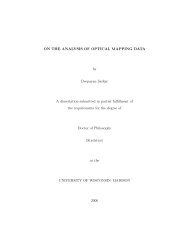Tiling Manifolds with Orthonormal Basis - Department of Statistics ...
Tiling Manifolds with Orthonormal Basis - Department of Statistics ...
Tiling Manifolds with Orthonormal Basis - Department of Statistics ...
You also want an ePaper? Increase the reach of your titles
YUMPU automatically turns print PDFs into web optimized ePapers that Google loves.
4<br />
Fig.2. Amygala surface flattening is done by tracing the geodesic path <strong>of</strong> the heat<br />
equilibrium state. The numbers corresponds to the different the geodesic contours. For<br />
simple shapes like amygde, 5 to 10 contours are sufficient for tracing the geodesic path.<br />
for all σ. The amygdala and the sphere serve as a heat source and a heat sink<br />
respectively. Then we solve an isotropic diffusion<br />
∂f<br />
= ∆f (2)<br />
∂σ<br />
<strong>with</strong>in the empty space bounded by the amygdala and the sphere. ∆ is the 3D<br />
Laplacian. After enough diffusion, the system reaches the heat equilibrium state<br />
where the additional diffusion does not make any difference in the heat distribution<br />
(Figure 1 middle). Once we obtained the equilibrium state, we trace the<br />
geodesic path from the heat source to the heat sink for every mesh vertices. The<br />
trajectory <strong>of</strong> the geodesic path provides a smooth mapping from the amygdala<br />
surface to the sphere. The geodesic path can be easily traced by constructing<br />
geodesic contours that correspond to the level set <strong>of</strong> the equilibrium state (Figure<br />
1 right). Then the geodesic path is constructed by finding the shortest distance<br />
from one contour to the next and iteratively connecting the path together. Figure<br />
2 shows the process <strong>of</strong> flattening using five contours corresponding to the<br />
temperature 0.6, 0.2, -0.2, -0.6, -1.0.<br />
Although we did not apply our flattening technique to other anatomical objects,<br />
the proposed method can be applied to more complex object than the<br />
amygdala. At the equilibrium state, we no longer has change in heat change over<br />
time, i.e. ∂f<br />
∂σ<br />
= 0, so we have the Laplace equation<br />
∆f = 0<br />
<strong>with</strong> the same boundary condition. The Laplace equation has been previously<br />
used to trace the distance between outer and inner cortical surfaces and to compute<br />
cortical thickness [10] [12] [19]. Since the solution to the Laplace equation<br />
<strong>with</strong> the boundary condition (1) is unique even for highly convoluted and folded<br />
structures, the geodesic path will be uniquely defined.<br />
2.2 Orhonormal basis in two sphere S 2<br />
Suppose a unit sphere S 2 is represented as a high resolution triangle mesh consisting<br />
<strong>of</strong> the vertex set V(S 2 ). We have used an almost uniformly sampled mesh
















